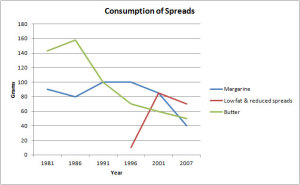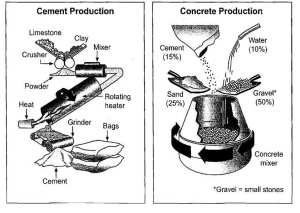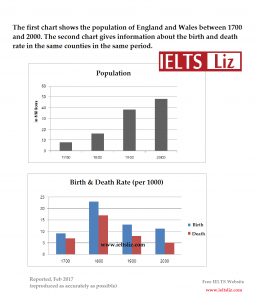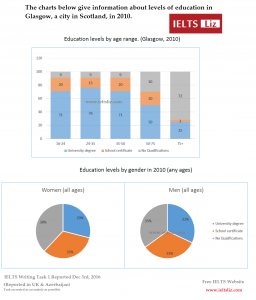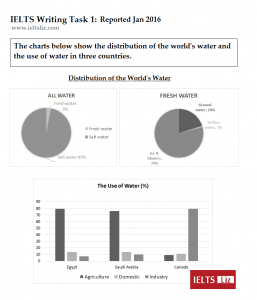This model line graph for IELTS is estimated at band score 9. The model answer below is for IELTS writing task 1 academic paper. Use this sample writing as a template for structure, key features and language for any IELTS line graph. There are also some tips given below to guide you and help you understand how to describe this type of graph.
IELTS Line Graph Sample Task
The graph below shows the consumption of 3 spreads from 1981 to 2007.
Source: Graph above not created by IELTS Liz. Source unknown.
IELTS Line Graph Answer
The line graph illustrates the amount of three kinds of spreads (margarine, low fat and reduced spreads and butter) which were consumed over 26 years from 1981 to 2007. Units are measured in grams.
Overall, the consumption of margarine and butter decreased over the period given, while for low fat and reduced spreads, it rose. At the start of the period, butter was the most popular spread, which was replaced by margarine from 1991 to 2001, and following that low fat and reduced spreads became the most widely used spread in the final years.
With regards to the amount of butter used, it began at around 140 grams and then peaked at 160 grams in 1986 before falling dramatically to about 50 grams in the last year. Likewise, approximately 90 grams of margarine was eaten in the first year after which the figure fluctuated slightly and dropped to a low of 40 grams in 2007.
On the other hand, the consumption of low fats and reduced spreads only started in 1996 at about 10 grams. This figure, which reached a high of just over 80 grams 5 years later, fell slightly in the final years to approximately 70 grams in 2007.
Tips for Line Graphs
- Paraphrase the line graph information for your introduction.
- Put main trends and any other key features in an overall statement.
- Make sure each body paragraph sentence has numbers and dates to support it.
- Check the video lesson below to learn how to write a complex sentence for an IELTS line graph report.
- Practice!! Click here: Practice Line Graphs to get a selection of sample line graphs to practice writing for your writing task 1 preparation.
Recommended Tutorials
- Bar Chart Model: Band Score 9
- Line Graph Vocabulary
- The 4 main complex sentences for a line graph: Video Tutorial
- All writing task 1 lessons and tips
……………………………………..

………………………………
Subscribe to get New Posts by Email

